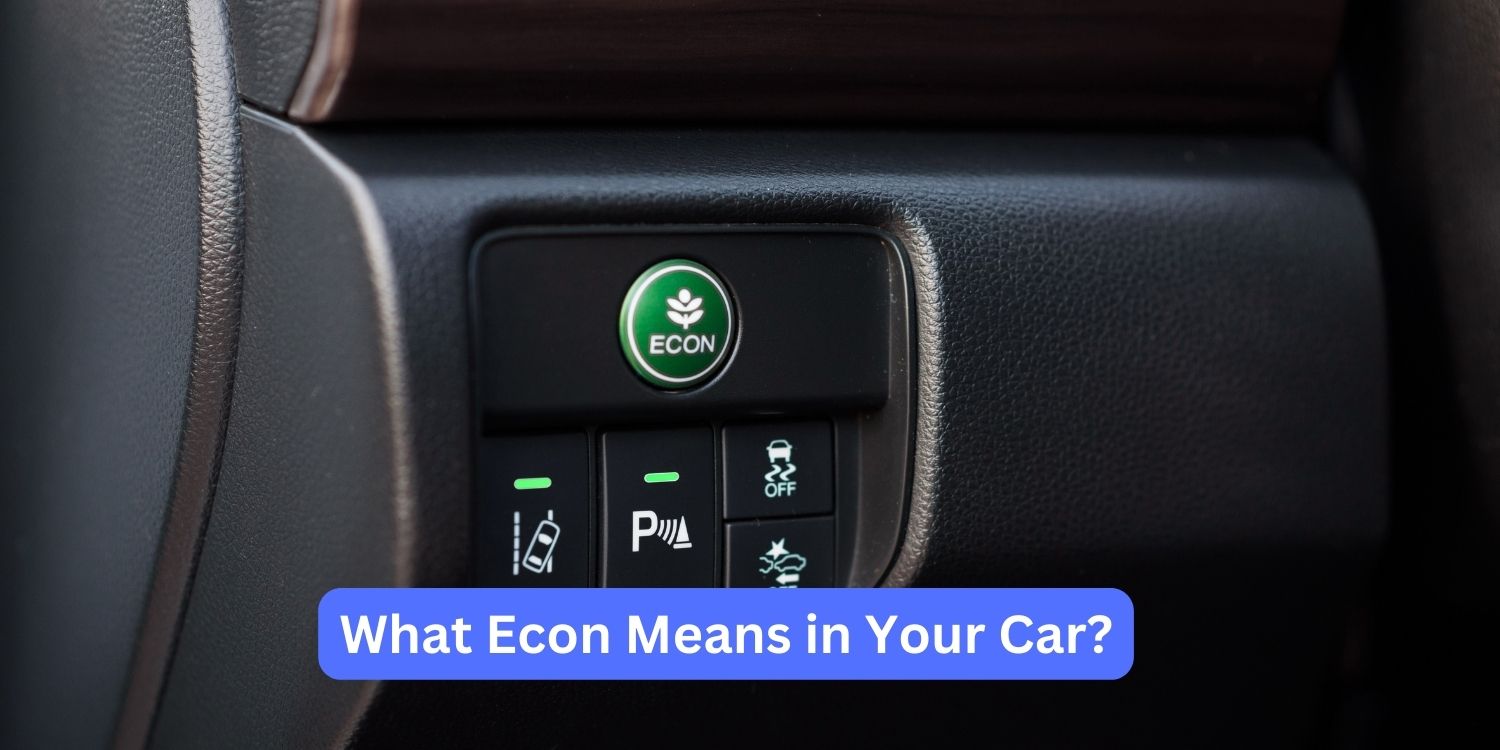Have you noticed an “Econ” option on your car’s dashboard? You might be wondering what it does.
This feature impacts your driving experience. Let’s learn about “Econ” mode and how it affects your vehicle’s performance. The “Econ” setting makes small changes to optimise fuel efficiency.
It may adjust things like gear shifts, acceleration, and air conditioning. This helps your car use less gas. But it can also mean slightly slower acceleration and response times.
The “Econ” mode works best for city driving or steady highway cruising. It can improve your miles per gallon.
For sportier performance, you’ll want to turn “Econ” off. This allows your car to operate at full power. So the “Econ” setting is useful for saving.
Understanding the Importance of “Econ”:
In the automobile world, “econ” usually means “economy” mode. This setting helps your vehicle use less fuel. It makes your car work smarter, not harder. When you turn on econ mode, your car adjusts its systems.
It may change how the engine runs or when the gears shift. The air conditioning might work differently too. But the main idea is simple: use less gas without sacrificing too much power.
Benefits of Econ Mode
Engaging in econ mode can yield several benefits for drivers:
1. Enhanced Fuel Efficiency
By optimizing engine and transmission settings, econ mode helps conserve fuel, ultimately reducing the frequency of refueling stops and overall fuel expenses.
2. Environmental Impact
Reduced fuel consumption translates to lower carbon emissions, contributing to environmental sustainability.
3. Extended Range
Improved fuel efficiency means drivers can cover more distance on a single tank of fuel, ideal for long drives or commutes.

Drawbacks of “Econ” Mode
While the “Econ” mode offers significant advantages, it also has some drawbacks:
Reduced Performance
One of the main trade-offs of activating the “Econ” mode is reduced performance. The adjustments made to optimize fuel efficiency may result in slower acceleration and overall diminished power.
Diminished Responsiveness
In some cases, drivers may notice a delay in throttle response or a lack of urgency when pressing the accelerator pedal, which can affect the vehicle’s responsiveness.
Activation and Functionality
Most vehicles enable econ mode through the dashboard controls or infotainment system. Engaging this mode allows the car’s computer to optimize performance parameters.
Fuel efficiency becomes the priority. Acceleration may feel slightly diminished, but overall driving dynamics remain satisfactory.
Econ mode’s primary objective centers around maximizing fuel economy. While some responsiveness is traded, the potential savings at the pump often outweigh minor compromises.
Drivers can comfortably operate in this setting for everyday journeys without significant inconvenience.
Key Considerations for Utilizing Econ Mode
Before activating econ mode, drivers must evaluate certain factors:
Driving Conditions
Econ mode may work best in city driving or consistent highway speeds. In stop-and-go traffic or when sudden acceleration is needed, the impact on performance may be more noticeable.
Personal Preferences
Some drivers prioritize performance over fuel efficiency. They may choose not to use econ mode regularly. Understanding personal driving preferences and priorities helps determine econ mode’s relevance for individual habits.
Vehicle Compatibility
Not all vehicles have econ mode, and functionality may vary between makes and models. Consult the owner’s manual or dealership for specific information on econ mode availability and operation.

Differences Between “Econ” Mode and Other Driving Modes
Unlike other drive modes, the “Econ” mode focuses solely on saving fuel. Its settings aim to maximize efficiency through engine and transmission tweaks. What do the alternatives offer?
- Sport mode trades fuel savings for heightened performance. It quickens throttle reactions and stiffens the suspension for sportier handling.
- Normal mode balances power and economy evenly. Neither sporty nor frugal, it provides an everyday middle ground.
- Eco mode, while similar to “Econ” mode, may lack the same degree of customization and fine-tuning for optimized efficiency.
Common Misconceptions About “Econ” Mode
Despite its widespread use, the “Econ” mode is often misunderstood. Here are some common misconceptions debunked:
1. It compromises safety
While “Econ” mode may alter certain vehicle settings, it does not compromise safety features such as braking or stability control.
2. It only saves fuel in city driving
“Econ” mode is effective in both city and highway driving conditions, helping to conserve fuel across various environments.
Learn more about How Long Does a Stolen Car Investigation Take.
Expert Opinions on the Effectiveness of “Econ” Mode:
Expert opinions discuss the effectiveness of the “Econ” mode.
Automotive professionals have shared their views on the “Econ” mode benefits:
Experts say “Their tests showed ‘Econ’ mode led to better gas mileage, mainly on highways. It’s a wise pick for eco-conscious drivers.”
Although ‘Econ’ mode reduces performance slightly, the fuel savings make it a useful feature.
FAQS
Some frequently asked questions about Econ” mode in cars are :
What is the “Econ” mode in cars?
“Econ” mode, short for “economy,” is a feature found in modern vehicles designed to optimize fuel efficiency by making adjustments to engine, transmission, and accessory settings
How does the “Econ” mode work?
When activated, “Econ” mode adjusts various systems within the vehicle to prioritize fuel conservation, such as altering engine power output, optimizing gear shifts, and modifying accessory usage like air conditioning.
What are the drawbacks of the “Econ” mode?
While the “Econ” mode offers advantages in fuel efficiency, it may also lead to reduced performance and responsiveness, particularly in terms of acceleration and throttle response.
How can drivers activate “Econ” mode in their vehicles?
Most vehicles enable “Econ” mode through dashboard controls or infotainment systems, allowing drivers to engage this mode to optimize performance parameters for fuel efficiency.
When is the best time to use “Econ” mode?
“Econ” mode is most effective during city driving or steady highway cruising, where consistent speeds and minimal acceleration variations allow for optimal fuel conservation.
Are there any common misconceptions about the “Econ” mode?
Yes, common misconceptions include the belief that the “Econ” mode compromises safety or is only effective in city driving, whereas it is suitable for various driving conditions and does not compromise safety features.
What do experts say about the effectiveness of the “Econ” mode?
Automotive professionals have conducted tests showing that “Econ” mode leads to improved gas mileage, particularly on highways, making it a valuable feature for eco-conscious drivers despite minor performance trade-offs.
Conclusion
Understanding “Econ” mode’s significance offers valuable insights to optimize driving. By delving into this feature’s nuances, drivers can leverage its benefits while navigating limitations adeptly.
Designed to prioritize efficiency without compromising too much performance, “Econ” mode, short for “economy”, subtly adjusts engine, transmission, and accessory settings.
Its aim is to help drivers conserve fuel, and reduce emissions, contributing to cost savings and environmental sustainability.
While activating “Econ” mode may slightly reduce responsiveness and performance, potential fuel savings often outweigh these minor trade-offs.
Drivers must weigh priorities and habits when deciding regular “Econ” mode engagement. What’s more, clearing up common misunderstandings about the “Econ” mode is key.
Some think it risks safety or only helps in cities – not true. Its versatility shines across different driving situations.
Experts back up the “Econ” mode’s ability to boost gas mileage, especially on highways.
Sure, you lose a bit of power, but the fuel savings make it a great choice for eco-friendly drivers.
At its core, “Econ” mode offers a practical way to drive more efficiently, without sacrificing the overall experience.
Grasping how it works, the benefits, and limits – that’s how drivers can optimize their trips while going easier on the environment.




